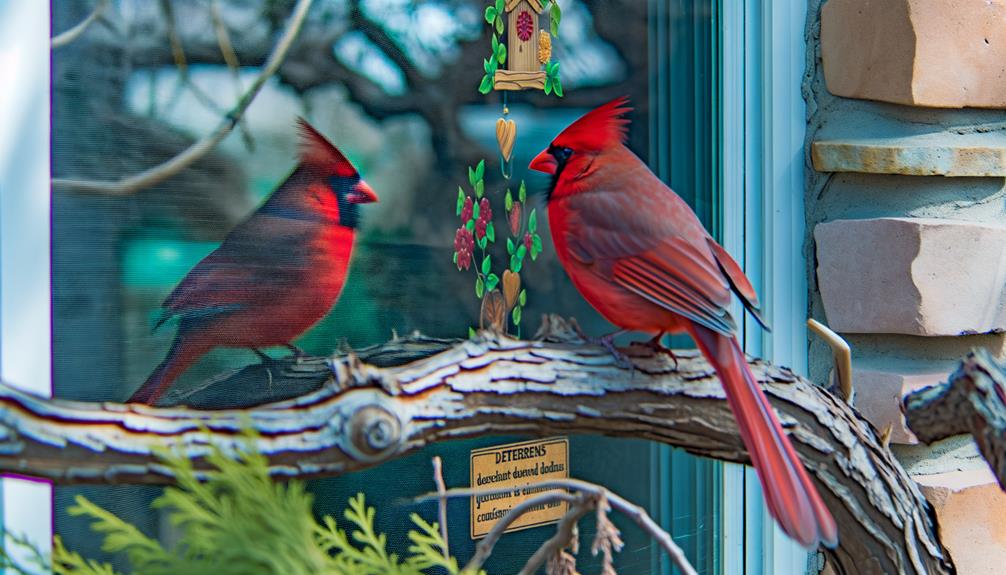Effective Tips to Stop Male Cardinal Pecking at Your Window
To stop a male cardinal from pecking at your window, first understand this behavior is driven by territorial instincts. The bird mistakes its reflection for a rival.
Reduce reflections by applying reflective tape or bird decals that mimic predators, disrupting his line of sight. Physical barriers like window screens or mesh reduce visibility and deter contact.
Alternative tactics include placing bird feeders and bird baths to divert his attention. For lasting results, consider adjusting interior lighting to minimize glass attraction and install decals as constant visual cues.
Exploring additional methods can secure a permanent solution.

Key Takeaways
- Apply non-reflective window films to reduce the cardinal's reflection and prevent pecking.
- Use bird decals or stickers on windows to interrupt reflections and deter territorial behavior.
- Install window screens or mesh to obscure reflections and act as a physical barrier.
- Hang reflective tapes or objects near the window to confuse and deter the cardinal.
- Place bird feeders or nesting materials away from windows to redirect the cardinal's attention.
Understanding Cardinal Behavior
Understanding why a male cardinal persistently pecks at windows involves examining its territorial instincts and mating behaviors.
You'll find that during breeding seasons, male cardinals exhibit heightened territoriality. They view their reflections as rival males encroaching on their territory, prompting aggressive pecking to ward off these perceived intruders. This behavior guarantees that the cardinal's nesting area remains secure for potential mates and offspring.
Additionally, the bright coloration of males during this period is a visual signal to attract females. The pecking is an instinct-driven response that reinforces their dominance and mating prospects.
Identifying the Triggers
To identify the triggers for a male cardinal pecking on your window, observe the reflection it perceives and its territory defense behavior.
Note the seasonal aggression patterns, particularly during breeding season.
Additionally, consider the proximity of nearby nesting sites that may increase territoriality.
Reflection and Territory Defense
Male cardinals often peck at windows due to the reflection, which they perceive as a rival intruding on their territory. This behavior is a territorial defense mechanism triggered by the bird's instinct to protect its nesting area.
When a cardinal spots its reflection, it mistakenly identifies it as another male, leading to aggressive pecking and fluttering against the glass. This misinterpretation is heightened by the bird's acute vision, which can easily detect even slight reflections.
Seasonal Aggression Patterns
Cardinals exhibit heightened aggression during breeding season, primarily from spring to early summer, driven by hormonal changes and the imperative to defend nesting sites. You'll notice male cardinals becoming particularly territorial, often mistaking their reflections for rival males. This behavior stems from their instinct to protect their mates and offspring. Recognizing the seasonal patterns can help you better understand and mitigate these behaviors.
| Season | Behavior | Trigger |
|---|---|---|
| Spring | Increased pecking | Breeding hormones |
| Early Summer | Aggressive displays | Nest defense |
| Late Summer | Reduced aggression | Post-breeding phase |
Nearby Nesting Sites
Identifying nearby nesting sites can reveal critical triggers for a male cardinal's aggressive pecking behavior. During the breeding season, male cardinals become highly territorial to protect their nests from perceived threats.
Look for nests in dense shrubs, low tree branches, or close to the house. The reflection of the male cardinal in your window likely appears as a rival male, prompting defensive pecking. Note the cardinal's frequent visitation times, which can indicate proximity to a nesting area.
Using Visual Deterrents
To deter the cardinal from pecking at your window, consider placing visual deterrents such as reflective tape or bird decals on the glass. Reflective tape disrupts the cardinal's line of sight by creating flashes of light, which can confuse and deter the bird. Bird decals mimic the appearance of predators or larger birds, signaling danger and discouraging approach.
Both methods rely on altering the visual stimuli that attract the cardinal to the window's reflective surface. Position these deterrents at regular intervals to maximize efficacy. Observations suggest that varying the patterns and types of visual deterrents can prevent habituation, ensuring the cardinal remains wary.
Implementing these methods can effectively reduce the frequency of pecking behavior.
Applying Physical Barriers
To prevent a male cardinal from pecking at your window, consider applying physical barriers.
You can install window screens, use bird tape, or hang reflective objects to obstruct the bird's view.
These measures reduce reflections and deter the bird's aggressive behavior.
Install Window Screens
Installing window screens provides an effective physical barrier that prevents male cardinals from pecking at your windows. When you install screens, you disrupt the reflective surface that cardinals mistake for intruding rivals. The mesh material reduces reflections and serves as a buffer, making it harder for the bird to reach the glass.
Choose screens with fine mesh to ensure maximum effectiveness. Measure your windows accurately to guarantee a snug fit, as gaps can render the barrier ineffective.
Additionally, installing screens can have dual benefits by also improving ventilation and minimizing insect intrusions. Observations indicate that cardinals are less likely to persist in pecking when they encounter this obstruction. This method is both humane and environmentally friendly, safeguarding both your windows and the bird.
Use Bird Tape
Applying bird tape to your windows creates an effective visual barrier that deters male cardinals from engaging in pecking behavior. This method disrupts the cardinal's reflection, thereby reducing territorial aggression. Bird tape is specially designed to be highly visible to birds but unobtrusive to humans, making it an ideal solution for minimizing window strikes and pecking.
To apply bird tape effectively, consider these steps:
- Measure and Cut: Cut the tape into strips or patterns that cover the window adequately.
- Spacing: Make sure strips are spaced no more than 2-4 inches apart.
- Clean Surface: Clean the window thoroughly before application for better adhesion.
- Press Firmly: Ensure to press the tape firmly against the glass to avoid peeling.
This method offers a scientifically-backed solution to mitigate avian window collisions.
Hang Reflective Objects
Hanging reflective objects, such as CDs or metallic streamers, disrupts a male cardinal's perception of territory by creating unpredictable light patterns that deter pecking behavior. These objects work by reflecting sunlight in various directions, causing visual confusion for the bird.
When the cardinal encounters these erratic reflections, it perceives the environment as unstable and unsuitable for establishing territory. To implement this method, you should hang reflective items outside the window at varying heights and positions. Make sure the objects can move freely with the wind, enhancing the deterrent effect.
Observations have shown that this approach notably reduces pecking incidents. By disturbing the cardinal's visual cues, you effectively discourage repetitive, aggressive behavior towards windows.
Creating Alternative Distractions
One effective method to deter a male cardinal from pecking on your window is to introduce alternative distractions that can redirect its attention. By creating stimuli that captivate the bird's interest, you can reduce its focus on its reflection.
Implementing these distractions can be achieved through several scientifically-backed strategies:
- Install a Bird Feeder: Position it away from windows to draw the cardinal to a new location.
- Provide Nesting Materials: Place natural fibers or yarn in your yard to encourage nesting behaviors.
- Create a Bird Bath: Freshwater sources can attract birds and provide an engaging area.
- Set Up Decoys: Use plastic birds or replicas to divert the cardinal's territorial instincts.
These methods can effectively minimize window pecking by providing alternative points of interest.
Long-term Prevention Strategies
Implementing long-term prevention strategies involves modifying the environment around your windows to permanently reduce the likelihood of a male cardinal pecking at its reflection. You can apply window films that create a non-reflective surface, install external shutters, or use screens to obscure the glass. Planting dense shrubs or trees near windows can also serve as a natural barrier. These methods target the bird's behavior by minimizing reflective surfaces.
| Strategy | Description | Effectiveness |
|---|---|---|
| Window Films | Non-reflective surface application | High |
| External Shutters | Physical barrier that covers the window | Moderate |
| Planting Shrubs/Trees | Natural barrier to obscure reflections | High |
Conclusion
While a male cardinal's persistent pecking on your window can be puzzling, understanding his behavior and identifying the triggers can offer solutions.
By juxtaposing visual deterrents and physical barriers with creating alternative distractions, you can effectively mitigate the issue.
Long-term prevention strategies, grounded in scientific observations and behavioral insights, secure a peaceful coexistence.
Employing these detailed steps not only protects your windows but also respects the cardinal's natural instincts and habitat.






